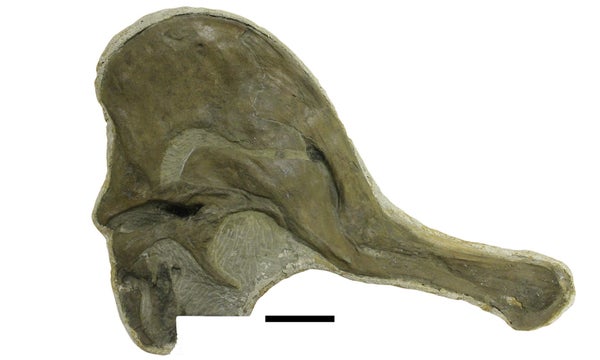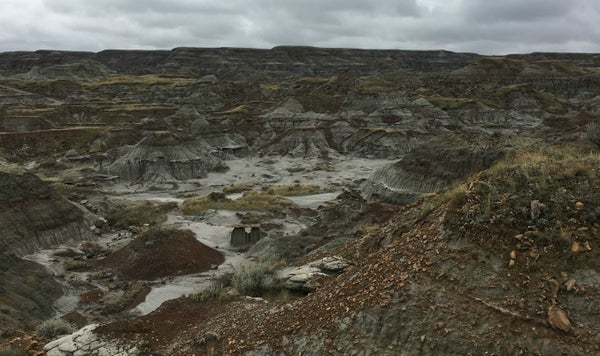This article was published in Scientific American’s former blog network and reflects the views of the author, not necessarily those of Scientific American
It’s hard not to like stories about long lost lovers reunited. Despite time and chance, they find their way back to each other to reaffirm their bond. There are fossil stories like this, too. Such tales may not be as purely romantic, but it still warms my heart to see a dinosaur’s head rejoined with its body after nearly a century apart.
Back in 1920, while hunting dinosaurs in an area now encompassed by Alberta’s Dinosaur Provincial Park, paleontologist George F. Sternberg excavated the cranium of a dome-crested duckbilled dinosaur. His colleague Charles Gilmore later used this fossil to name the dinosaur Corythosaurus excavatus. But was there ever anything more of the dinosaur? Sternberg didn’t leave good notes behind – a pet peeve of modern paleontologists – so there was no way to tell whether the cranium was all there was or if the rest was left behind. Now paleontologist Katherine Bramble and colleagues think they know the answer.
The trail of this peculiar, decapitated dinosaur picked up again in 1992. In that year an examination of a site called Bonebed 50 turned up the front part of a hadrosaur skeleton that had been previously excavated and abandoned, including a lower jaw. The dentary was collected, but no one thought much of the skeleton and it was left in place for visitors to see.
A little bit of erosion changed the story. In 2011 pieces of plaster and newspaper clippings from 1920 turned up at the bonebed, Bramble and coauthors write. Sternberg had been here. And even though Sternberg wasn’t great about taking notes, the historical record was clear he was the only collector working in the area at the time and that the only significant hadrosaur find he made in the 1920 season was the cranium that would later become Corythosaurus excavatus. Once the connection was made, a University of Alberta crew collected the rest of the hadrosaur skeleton in the hope of saving the rest of the holotype.
On supporting science journalism
If you're enjoying this article, consider supporting our award-winning journalism by subscribing. By purchasing a subscription you are helping to ensure the future of impactful stories about the discoveries and ideas shaping our world today.
Head hunting was common in Sternberg’s time. Hadrosaurs and horned dinosaurs, especially, seemed to have vastly different skulls on relatively similar skeletal chassis, so the skull was far more important to recover than the whole skeleton. (Even in modern descriptions of new hadrosaurs and horned dinosaurs where skulls and postcrania alike are collected, the emphasis is placed on the skull while the rest of the body is often treated as an anatomical afterthought.) But even though the archaeological tidbits seemed to link the Corythosaurus cranium with the body finally excavated in 2012, how could paleontologists be sure? This is where the new study by Bramble and colleagues comes in.

The skull of Corythosaurus excavatus. Credit: Bramble et al. 2017
Working with the skull, the dentary collected in 1992, and the skeleton excavated in 2012, Bramble and coauthors looked to the proportions of other hadrosaur skeletons to see if the various pieces were within the right range to belong to the same individual. One detail in favor of association is that all the pieces appear to be from the right side of the body. The dentary, as well, appears to be a good anatomical and statistical fit for the cranium. Where it gets tricky is the rest of the skeleton. Measurements of the femur, for example, came out slightly larger than estimated for skull size, although still within the range of variation for hadrosaurs. In all, Bramble and coauthors write, “it is plausible that the dentary and postcranial bones could belong with the UALVP 13 skull.”
The connection isn’t quite so neat as two pieces of a bone that perfectly fit each other, but there’s still a good case that the body in Bonebed 50 fits with the isolated Corythosaurus skull. If it does, that gives paleontologists a much more detailed sample to examine whether Corythosaurus excavatus deserves to be a separate species or, as most experts have accepted, is a synonym for another Corythosaurus species. But even if that question is never resolved, the new study gives us hope that head hunted dinosaurs might be able to be made whole again. What biology has brought together may no paleontologist separate.
Reference:
Bramble, K., Currie, P., Tanke, D., Torices, A. 2017. Reuniting the “head hunted” Corythosaurus excavatus (Dinosauria: Hadrosauridae) holotype skull with its dentary and postcranium. Cretaceous Research. doi: 10.1016/j.cretres.2017.04.006
